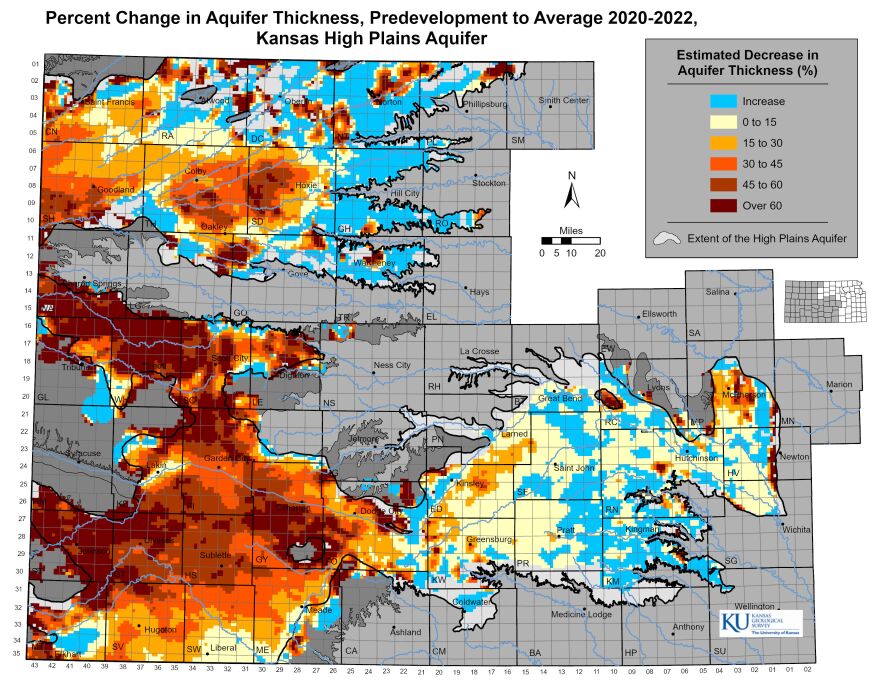Colby, KS — The board that advises the Kansas governor and Legislature on water policy now says the state needs to dramatically cut farming irrigation to stop draining the Ogallala aquifer.
The vote by the Kansas Water Authority on Wednesday signals a call for a major shift in state policy. For the first time, a state entity has stated that Kansas should move away from gradually depleting the aquifer and act to halt the decline of the vital underground reservoir.
Kansas Water Office director Connie Owen called the vote a historic step in changing how the state manages the aquifer, which has lost more than one-third of its water in recent decades.
“It is enormous,” Owen said, “because there has yet to be any state entity that has publicly acknowledged the problem … and made a statement that we can no longer behave as we have been.”
The water authority will now send this official recommendation to the governor and Legislature in its annual report.

The Kansas Water Authority’s 13 voting members are appointed by the governor and Legislature and come from across the state, each representing various interests related to water — from irrigation to conservation to city drinking supplies.
Lynn Goossen, the KWA voting member from Colby, also serves on the board of the northwest Kansas groundwater management district that has been reducing water use with irrigation limits since 2017.
“This should have been done 15 years ago,” Goossen said. “It’s something that the longer we put it off, the more critical it’s going to be.”
The lone vote against the measure came from Randy Hayzlett, the board’s member from Lakin in southwest Kansas. That part of the state relies most heavily on water from the aquifer for irrigation and its economy would suffer most acutely from new pumping restrictions. Hayzlett is also on the board of that region’s groundwater management district, which has shied away from widespread irrigation cuts.
He said the word “halt” in the recommendation to stop the aquifer’s decline went too far.
“That’s a pretty strong word and it’s going to affect a lot of people,” Hayzlett said. “Is it going to help declines in the aquifer? Or is it going to help the economies in western Kansas? Just what’s it gonna put a cap on?”

For decades, state policy essentially approved the gradual draining of the Ogallala aquifer to maintain an agricultural economy that had grown to depend on irrigation. The state handed out more water rights than the aquifer could handle. In the years since then, it has proven tough to get farmers to voluntarily give up those rights.
In western Kansas, nearly all of the water used from the aquifer goes to irrigate crops. Estimates predict that if pumping continues, more than two-thirds of the water will be lost within the next 40 years. Stanton and Wallace counties along the Colorado border have already seen more than 75% of their water slip away since irrigation began.
At this point, western Kansas would need to cut irrigation significantly to even get close to reach sustainability. Kansas Geological Survey analysis shows that four counties in west-central Kansas, for instance, would need to reduce their water use by roughly one-third in an average year to stop the aquifer’s decline. In a drought year like this one, those counties would need to cut irrigation by one-half.
Some local groundwater districts have seen success in recent years with getting farmers on board to begin reducing the amount of water they use, but efforts to curb aquifer declines at the state level haven’t gotten very far.

Legislation proposed early this year could have forced aquifer management districts in western and central Kansas to place stricter limits on water usage to slow the depletion rate. But those sections of the bill were removed during committee discussions, leaving some legislators frustrated with how the agriculture industry’s influence continues to thwart water conservation measures.
State Rep. Lindsey Vaughn, a Johnson County Democrat on the water committee, said new limits would mark a sharp change.
“It does feel historic,” Vaughn said, “for us to be in this water authority meeting with people from across the state saying, ‘We really want to do something about this, and now’s the time.’”
Based on history, it will still likely be an uphill climb to get lawmakers to agree on irrigation cutbacks. But Vaughn said she is hopeful this statement will pressure lawmakers on a contentious issue.
In the upcoming legislative session, lawmakers will have several opportunities to address aquifer depletion. The body will conduct an audit of the groundwater management districts to see how effective each district has been at conserving the aquifer.
Lawmakers will also look at ways to increase state funding, Vaughn said, to address the declining aquifer and other pressing water issues. The state put $8 million toward its water plan this past year, but analyses indicate the actual amount it would take to fund the state’s water needs is more than $50 million. That funding could go toward helping farmers buy and use the latest irrigation technology that uses water more efficiently and informs farmers when they need or don’t need to irrigate.
She said this message from that board now calls for a response from lawmakers.
“That’s a mandate for the Legislature to come forward with suggestions for what we’re going to do to try and take action on this issue,” Vaughn said. “That puts more pressure on us to get something done.”
David Condos covers western Kansas for High Plains Public Radio and the Kansas News Service. You can follow him on Twitter@davidcondos.
The Kansas News Service is a collaboration of KCUR, Kansas Public Radio, KMUW and High Plains Public Radio focused on health, the social determinants of health and their connection to public policy.
Kansas News Service stories and photos may be republished by news media at no cost with proper attribution and a link to ksnewsservice.org.













